- Home
- Dante Alighieri
The Divine Comedy Page 2
The Divine Comedy Read online
Page 2
Dante was a parochial man. He was persuaded that the One Truth had been revealed to him, and he was intolerant of all non-Catholic views. He refused, for example, to think of Mohammed as a religious leader but dismissed him as schismatic and heretic and assigned to him a particularly grotesque punishment in Hell.
But if the man was parochial, the artist was universal as only art can be. The Divine Comedy is a triumph of art over creed. And that triumph—to paraphrase terms that Dante himself might have used—arises from the force of the Esthetic Mysteries, which is to say, the power of form in the interplay of its structures and its levels of meaning.
The first obvious level, for example, is narrative: a travelogue. But that journey is through a country populated by second meanings. On one level Dante writes of Hell as a literal place of sin and punishment. The damned are there because they offended a theological system that enforces certain consequences of suffering. But part of that theological system has also decreed that salvation was available to all men. Christ in his ransom had procured endless mercy. One need only wish to be saved, need only surrender his soul to God in a last gasp of contrition, and he will be saved. He may have to suffer at length in Purgatory, but, once there, his place is reserved in Heaven and he will in time arrive there. Purgatory is like our modern colleges: no one can flunk out of them.
It follows, then, that the only way to get into Hell is to insist upon it. One must deliberately exclude himself from grace by hardening his heart against it. Hell is what the damned have actively and insistently wished for.
Thus, allegorically, Hell is the true goal of the damned. On the surface the state of the sinners is described in terms of sin. The wonder and the universality of it is that a reader who does not care for those terms may restate them in terms of behavior, and the Inferno remains entirely coherent as a dramatic treatise on self-destructive behavior. Like addicts, the damned both hate and love their self-destruction. “They yearn for what they fear,” says Dante.
Thus Hell is not only a specific place but a moral and anagogical allegory of the guilty conscience of the damned. It is the projection into a physical reality of the inner state of the damned. As Purgatory is such a projection of the inner state of those who suffer toward grace. As Heaven is such another projection of the inner state of those who have achieved grace. Each environment is an allegory and a moral and anagogical commentary on the essential nature of the souls one finds in each. Hell exists from within.
In a detailed discussion in the Purgatorio, Dante reinforces these levels of meaning by pointing out that though mortal man may deceive by hiding his true nature under false semblances, the dead, by the very nature of their aerial bodies, can only appear to be exactly what they are. The dead cannot dissemble. What they appear to be and where they appear, they are.
The third theme—let it be called the Moral Universe or the Sentient Universe—is the vast, overriding concept of the total universe that makes the Divine Comedy the massive vehicle it is. Every artist seeks the vehicle that will best engage all his possibilities, just as every actor seeks the perfect role for himself. So, any actor would rather play Hamlet than Uncle Tom. Hamlet gives him more chances to act.
Dante’s vehicle is nothing less than the total universe. Where in all poetry is there an equivalent subject-structure? Dante not only draws a map of his universe; he walks it from end to end. But his map is both of a physical geography and of a structure of values. That universe exists on all five levels of meaning.
For Dante, as for classical man, there was no real distinction between moral and physical law; between, say, the moral law against incest and the physical law of gravity. All of matter was a projection of God’s will, and what we call physical law and what we call moral law derived equally from that will. When Oedipus, though unknowingly, transgressed moral law by killing his father and marrying his mother, a plague descended upon Thebes. It would not have occurred to the Greeks that to think of a flight of locusts as a consequence of what happened in the king’s bedroom was to cross categories.
Dante’s physical universe is Ptolemaic. It consists of nine concentric circles (spheres) with the earth as the center. In ascending order those spheres are: the Moon, Mercury, Venus, the Sun, Mars, Jupiter, Saturn, the Fixed Stars, and the Primum Mobile. Beyond the Primum Mobile lies the Empyrean, which is the dwelling and presence of God. God is an essence that entirely surrounds and contains creation.
If God is the circumference of this nine-layered sphere, the center is the greatest distance one can travel from God. That center is the earth, and the center of that center is the bottom of Hell. Inevitably, it is there, at the Ultimate bottom of the universe, that Dante places Satan.
Satan is a powerful symbol. He is described as an unholy reverse-Trinity with three foul heads and three pairs of wings. He has been flung from Heaven to the farthest distance one can go from God. To his dark center drain all the waters of the earth, bearing the filthy sediment of all sin and uncleanliness. Satan’s six wings beat madly in his efforts to escape from that foul lake but they succeed only in whipping up a freezing gale that turns all to ice, fixing him ever more securely in the bottom ice-tray. From the top of Purgatory, moreover, there flow down to him the waters of Lethe, in which the finally purified souls bathe and are washed clean of every memory of sin. That memory, too, is frozen into the filthy ice about Satan.
Thus that center is the center of all weight, of all sin, of all darkness, and of all cold. And to it flows all the filth of time. Weight, sin, dark, cold, and filth are, of course, the five things farthest from God. And thus the universe becomes a scale of precise values: the closer a thing is to the center, the lower it is on that scale; the closer a thing is to the circumference, the higher it is.
The existence of that scale makes possible an enormous economy in Dante’s writing. Dante need only place his finger on that map and say what he saw there. The very act of placement becomes the value judgment.
That economy is further assisted by the firm laws of the other world. As one sins, so he is punished; as he strove for grace, so is he rewarded. In Hell, then, each punishment is a symbolic analysis of the nature of the sin and of the state of the sinner’s soul. The reader need only be told, for example, that the punishment of the Lustful is highest in the Infernal scale, and that it consists of being buffeted eternally round and round by a dark whirlwind. The reader knows at once that this sin, though sufficient for damnation, is the least weighty of all the sins of Hell proper, and that the nature of the sin is to allow one’s soul to be buffeted round and round by the dark winds of immoderate passion. Love is a sweet human state, but by excessive physical love these sinners shut their souls from God, surrendering “reason to their appetites.”
Dante’s Cantos average about 140 lines. As a general thing he requires no more than twenty or thirty lines to identify the sinner and to describe the punishment. Since the value judgment is already established by the map, and since the punishment is a symbolic analysis of the sin, these essential matters are settled in short order, and Dante has the rest of his Canto available for all sorts of matters that attract his ranging mind.
Dante had once set out to be an encyclopedist. His Il Convivio—never finished—was an effort to set down in Italian all human “science.” There is nothing that does not interest him. As a poet, moreover, he would naturally look for chances to use his dramatic, lyric, and didactic powers. So, with his structure firmly determined by its basic economy, Dante is free to range at will, packing every rift with those fascinating details that add so much to his poem. He has time for gossip, for prophecies, for marvelous dramatic interplays, for treatises on history, for analyzing the French monarchy, the corruption of the Church, the decay of Italian politics. He has time for all sorts of metaphysical treatises on such matters as the nature of the generative principle, literary criticism, meteorology—in short, for his whole unfinished encyclopedia. And he still has time to invent a death for Ulysses, to engage in a me
tamorphic contest with Ovid, to make side remarks to his friends. He can give full rein to his powers because he has found the inexhaustible vehicle.
The fourth principal theme will inevitably reveal itself to the careful reader, but he will lose nothing by having it in mind from the start. Call it the Architectonics. The Divine Comedy has often been compared to a cathedral, and, whether or not the comparison is finally apt, it is certainly true that Dante’s details keep acquiring significance as one goes on and learns to look back at them from some corresponding point in the later structure. The structure, that is to say, produces a back-illumination .
Charon, for example, is the boatman of the damned, ferrying them across Acheron into Hell proper. He is a memorable figure. Later, one meets the Angel-Pilot who ferries souls to Purgatory. He, too, is a memorable figure. But no reasonably careful reader can fail to see that one ferryman stands in meaningful relation to the other. Thus, the Angel is not only himself, but an opposite figure to Charon, and Charon seen backwards from the figure of the Angel acquires a dimension he did not have as an isolated figure. The development of these structural correspondences—of an endless number of them—is an everlasting and ever-enlarging source of the power of the Divine Comedy.
The supreme art of poetry is not to assert meaning but to release it by the juxtaposition of poetic elements. Form, in its interrelations, is the most speaking element. Because in any extended poetic structure these juxtapositions will fall into different perspectives when looked at from different points of vantage, that release of meaning is subject to endless meaningful reinterpretation. The inexhaustibility of the Divine Comedy is a consequence of this structural quality. It is for that reason that no one can ever finish reading it. There will always be a new way of viewing the elements. But if no man can finish the poem, any man may begin it and be the richer for having begun. The present imperfect gloss—skimming though it be—is really about all one needs to start with. And, having started, all he needs is to pay attention. The poem itself is the rest of the way, and the way is marked.
TRANSLATOR’S NOTE
Any theoretical remarks offered by a translator are bound to be an apology for his failures. Obviously no sane translator can allow himself to dream of success. He asks only for the best possible failure.
Translation is, in fact, the wrong word for the process of rendering from one language to another. The idea of “translation” seems to suggest that there exists in Language A some word that will equal any given word in Language B, and that the translator need only find that equivalent word and put it in place, allowing of course for something called “idiom.”
But such an assumption ignores the nature of words. The American word “daisy,” for example, labels the same flower the French intend by la marguerite and the Italians by la margherita—or at least approximately so: a botanist might be quick to say that the varieties of the European daisy are distinct from those of the American daisy. Nevertheless, those are the words one would naturally use in these three tongues for labeling any particular daisy. Semantically, that is to say, the denotations are reasonably firm.
But words consist of much more than denotation. Every word has a certain muscularity. That is to say, it involves certain speech muscles. Certainly any man who is a word-sensitive is likely to linger over the difference between the long-drawn Italian carina and the common, though imprecise, American usage “cute” when applied to an attractive child. The physical gestures the two words invite are at least as different as the Italian child’s good-bye wave (“Fa ciao, carina”) with the palm of the hand up, and the American child’s (“Wave bye-bye”) with the back of the hand up. The very difference in ethnic concept between two peoples moves the words about in their mouths. As I once wrote in a poem I am not moved to cherish particularly but whose point remains:My mother facing a day in Avellino
Tasted it: una dolce giornata.
My wife’s mother in Protestant Missouri
Judges it: it is a good day.
These are two distinct kinds of muscularity. Other kinds could certainly be adduced. And all must function in the effort one must make to find truly equivalent language.
Every word, moreover, has a history. Sometimes the history changes out from under the word very rapidly. English “broadcast” once meant specifically “a way of sowing” and was borrowed by radio as an analogy. Meanwhile new machines all but eliminated the old methods of broadcast-sowing, and the word has just about lost all farm-connotation. What to do then when, to shift examples, one language uses a word denoting anxiety whose essential meaning is based on the history of medieval torture, when the only word in another language that will render that denotation is based on the history of, say, the internal-combustion engine? Pure hypotheticals, to be sure, but how does one find equivalents in any language for such English words as “billingsgate,” or “to burke,” or “boycott”?—words whose meanings are inseparable from the local scene and local history in which the English language evolved?
Every word has an image locked into its roots. The English word “daisy” is a contraction of the earlier “day’s eye,” which is to say, “the eye of day”—a lovely root image. Marguerite and margherita also have a root connotation of all girls named Margaret/Marguerite/ Margherita—and bless them all as lovely images. Behind that first suggestion, too, lies the true root of the Greek margaron, meaning “pearl”—another fine image. But what happened to “day’s eye”? Not that there is any point here in arguing which is the more attractive root image. The point is simply that they are different. And what then does one do for equivalent words?
And to point out only one more of many possibilities within the nature of words, every word connotes a certain level of usage. Italian antipatico , for example, is so common a usage that it falls readily from the lips of even very small children, whereas English “antipathetic” is a relatively learned word, and certainly not one for the normal nursery. What weight does one give this element of word usage in seeking equivalents?
We tend to use only the top slice of a word in speech usage. But once the other levels of a word are allowed into consideration, no word is a simple thing. It becomes a complex. But if a single word is a complex, then a phrase is a complex of complexes, and a line is a complex of complexes of complexes, and a stanza, and a poem are . . . and so forth and so on.
I don’t honestly know how one makes a theory of translation out of these musings and bewilderments. All I can truthfully say is that such equivalence as I have managed has happened by feel, and that I am more comfortable within specifications than I am in trying to defend theories that distort under every effort to state them.
I began to peck away at Dante because I could find no translation that satisfied my sense of the original. Let nothing in that statement imply that I have now satisfied my sense. When I read the original with my rendering in mind I have no choice but to feel sad. When I read any other translation with my rendering in mind, I feel relatively happy. No one, of course, should trust my sense of it, but I must. Whose sense can I trust else?
In looking at other translations I was distressed by the fact that none of them seemed to be using what I understood to be Dante’s vulgate. They seemed rather to fall into literary language, the very sort of thing Dante took such pains to avoid. And none of them, above all else, gave me a satisfying sense of Dante’s pace, which is to say, “the rate at which the writing reveals itself to the reader.”
I began to experiment out of curiosity. I rendered a number of Cantos in terza rima and satisfied myself that it could not do. English is a rhyme-poor language. It was obvious to me that the price of forcing that third rhyme into place in English was ruinous to the language. There are approximately 4,500 lines in each third of the Divine Comedy. One must find 1,500 triple-rhymes to render each third into terza rima, and English has no such rhyme-resources. Mechanically, it can be done, but not in anything approximating spoken American-English. I could see through what wrestling agoni
es I had put my own efforts in order to force the language around to that third rhyme, and the same agonies are immediately visible in every extant version in terza rima.
Abandoning all thought of terza rima, I tried blank verse. But there the language and its movement went askew on another characteristic of English verse. The blank-verse paragraph in English, as nearly as I can determine, runs to an average of about fourteen lines. (Interestingly, the paragraph of Pope’s couplets runs to about the same average.) If one thinks of the structure of pauses in a poem as subtotaling points, I take that fact of English poetry to mean that blank verse pauses to complete its sub-thoughts about once every fourteen lines. But Dante sets his pauses (which is to say, his periods, or more usually his semicolons, or sometimes his commas) every three lines, and I take that fact to be, above all else, what determines the pace and sparseness of Dante’s writing. If the fundamental unit runs from ten to twenty lines, there is room for all sorts of digression or even self-indulgence. An extra line or two, an extra image or two, an extra flourish or two, are easily possible. But if one is forcing his lines to some sort of summary every three lines, that fact must work to squeeze out all flab. Dante does, to be sure, write any number of run-on tercets, but the three-line unit remains firm as the rigorous basic measure of his way of writing. This writing is of bone and sinew.
I went on to experiment with all sorts of other possibilities. In another effort at terza rima I tried assonantal rhyming. Assonance may yet be a possibility for someone else. I can only report that I do not favor it as an English rhyme-method. For a time I tried English couplets, thinking they might be made to render an Italian tercet: they cannot, at least as a sustained measure. I tried various sorts of ballad stanzas: they had no hope of being for anything but the wastebasket. Then I hit on what I may as well call dummy terza rima, which is to say, I kept the three-line unit but rhymed only the first and third lines. And with that it began to happen, at least for me. I could persuade myself that what came was reasonably English, reasonably poetry, and reasonably faithful to Dante’s pace and to his special way of using language. What is reasonable can, of course, include an awareness of failure, but I could begin to believe this was a good enough failure to be worth investing in.

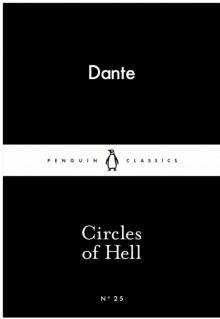 Circles of Hell
Circles of Hell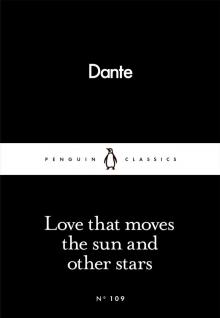 Love That Moves the Sun and Other Stars
Love That Moves the Sun and Other Stars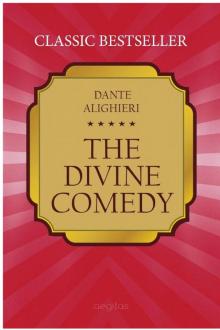 The Divine Comedy
The Divine Comedy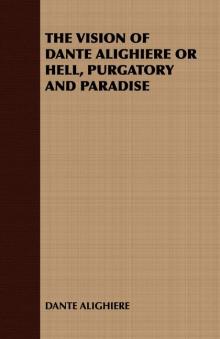 The Vision of Dante Alighiere or Hell, Purgatory and Paradise
The Vision of Dante Alighiere or Hell, Purgatory and Paradise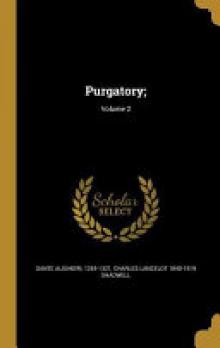 Purgatory
Purgatory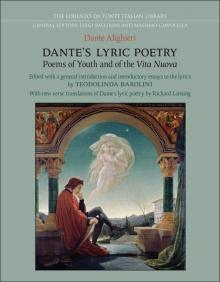 Dante's Lyric Poems (Italian Poetry in Translation)
Dante's Lyric Poems (Italian Poetry in Translation)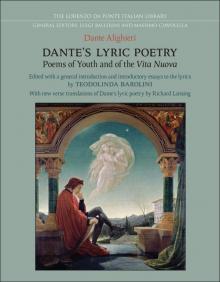 Dante's Lyric Poetry: Poems of Youth and of the 'Vita Nuova'
Dante's Lyric Poetry: Poems of Youth and of the 'Vita Nuova'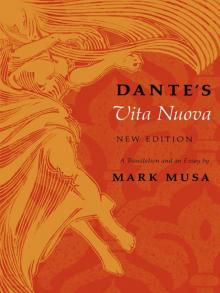 Dante’s Vita Nuova, New Edition: A Translation and an Essay
Dante’s Vita Nuova, New Edition: A Translation and an Essay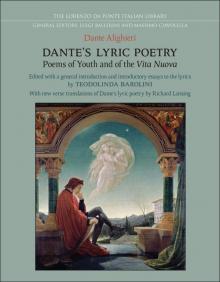 Dante's Lyric Poetry
Dante's Lyric Poetry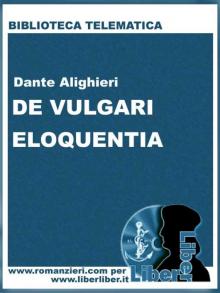 De vulgari eloquentia
De vulgari eloquentia The Inferno (Barnes & Noble Classics Series)
The Inferno (Barnes & Noble Classics Series)